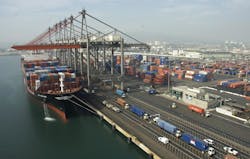Infrastructure, technology, and workers key to supply chain competitiveness
As both Democrat and Republican members of Congress continue to work on crafting a surface transportation bill – which will either be another short-term funding extension or more permanent multi-year legislation – those dealing with the daily grind down in the supply chain trenches believe such efforts at the federal level need to be more tightly focused on the infrastructure and workforce needs of the freight world.
“We believe that the next surface transportation authorization bill must include a cohesive national freight policy that focuses on improving all services in a collective manner,” noted Kelly Kolb, VP-government affairs for the Retail Industry Leaders Association (RILA) in testimony on Capitol Hill in late January."Access to efficient and reliable transportation systems is a vital component to the success of America’s retailers,” she added. “Our freight arrives by using a combination of planes, trains, ships, and trucks. When a disturbance occurs in the system, it has a ripple effect on retailer’s supply chain operations.”
Kolb (at right) pointed out that establishing a national freight policy is critical for the future of our economy and for maintaining global competitiveness.
“Retailers need a national policy that helps facilitate the free flow of commerce and includes strategic investments in vital corridors and crucial connections in our system,” she said.
Yet Tony McGee, CEO of Orlando-based HNM Global Logistics, told Fleet Owner that improving the U.S. supply chain is not just limited to improving and expanding the nation’s network of roads, bridges, rails and ports. It’s also about deploying more technology and attracting more workers to the transportation and logistics profession.
“One of things we really aren’t talking about is how to deploy technology to help us alleviate bottlenecks,” he said. “For example we have mobile apps that can really help us better manage truck traffic at the ports, but they are not used widely enough.”
Tom Hullinger, HNM’s COO, added that developing more “freight-focused” technology also increases the need for more information technology (IT) specialists and engineers to enter the transportation field along with more “bedrock” workers such as truck drivers, technicians, and others to alleviate ongoing shortages.
“I’m particularly frustrated with how we are guiding education in this country,” he said. “We’ve gotten away from vocational education to the point where if a high school graduate does not want to go to college, they don’t have many other places to go.”
Hullinger stressed, too, that major freight infrastructure improvements will come to naught if there aren’t enough people in the workforce to manage and operate it.
Both McGee and Hullinger pointed out, too, that freight congestion is being exacerbated by labor issues particularly at “chokepoints” such as the West Coast ports of Los Angeles and Long Beach.
“Those are the primary ports for the bulk of containers coming in from Asia,” Hullinger said. “So the longshoremen there will continue to use that to their advantage, using work stoppages and slowdowns to leverage better pay and benefits.”
RILA’s Kolb noted that, in coming years, freight volumes are expected to double, with such volume increases creating additional costs for shippers and further increasing freight congestion throughout the transportation system.
“It is vital that we look at the complete connectivity of the supply chain, including the last mile connectors,” she added. “Last mile connectors make available a smooth transition between the highway system and freight facilities. If connectors are a weak link in the system, they will most certainly raise shipping costs, as well as reduce the productivity and competitiveness of U.S. businesses.”
To that end, HNM’s Hullinger believes one the primary points of infrastructure focus needs to be beefing up U.S. port capacity, along with the rail and road systems necessary to transport ocean freight inland.
“Alternative West Coast ports such as Oakland and Seattle – along with East Coast ports when the widening of the Panama Canal is completed – need more dredging to accommodate bigger container ships, along with bigger [container] cranes and more of them,” he said. “We also need more rail and road capacity to more freight out of those ports too.”
HNM’s McGee added that particular attention needs to be placed on improving and expanding the U.S. roads and bridge network – something he characterized as a “red headed stepchild” when it comes to national freight policy planning.
“The highway system is very old – it was originally build in the 1950s,” he explained. “There’s still not enough realization of just how much an impact just widening roads can have in terms of alleviating congestion and improving freight delivery. Because alleviating freight congestion domestically will be the foundation for improving our nation’s supply chain competitiveness.”
About the Author
Sean Kilcarr
Editor in Chief
Sean Kilcarr is a former longtime FleetOwner senior editor who wrote for the publication from 2000 to 2018. He served as editor-in-chief from 2017 to 2018.

